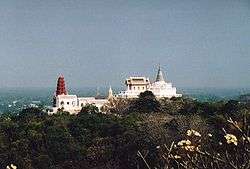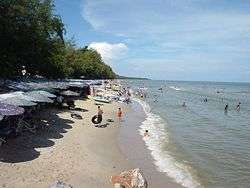Phetchaburi Province
| Phetchaburi เพชรบุรี | ||
|---|---|---|
| Province | ||
|
Cha-am Beach | ||
| ||
 Map of Thailand highlighting Phetchaburi Province | ||
| Country | Thailand | |
| Capital | Phetchaburi town | |
| Government | ||
| • Governor | Chatphon Ratdutsadi (since October 2016) | |
| Area | ||
| • Total | 6,225.1 km2 (2,403.5 sq mi) | |
| Area rank | Ranked 36th | |
| Population (2014) | ||
| • Total | 474,192 | |
| • Rank | Ranked 58th | |
| • Density | 76/km2 (200/sq mi) | |
| • Density rank | Ranked 68th | |
| Time zone | ICT (UTC+7) | |
| ISO 3166 code | TH-76 | |
Phetchaburi (Thai: เพชรบุรี, pronounced [pʰét.t͡ɕʰā.bū.rīː]) is one of the western or central provinces (changwat) of Thailand.[1] Neighboring provinces are (from north clockwise) Ratchaburi, Samut Songkhram, and Prachuap Khiri Khan. In the west it borders Tanintharyi Division of Myanmar. Phetchaburi has a national park called "Kaeng Krachan" which consists of a reservoir overlooking its islands.[2]
Geography
Phetchaburi is at the north end of the Malay Peninsula, with the Gulf of Thailand to the east and the Tanaosi mountain range forming the boundary to Myanmar. Except for these border mountains most of the province is a flat plain. With an area of about 3,000 km² the Kaeng Krachan National Park is Thailand's largest national park, covering nearly half of the province.[2] It protects mostly rain forests in the mountains along the boundary to Myanmar, but also the Kaeng Krachan Reservoir is part of the park. The only significant river of the province is the Phetchaburi River.
History

Phetchaburi is an old royal city, dating back to the Mon of the 8th century. Later Khmer settled in the city, as can be seen by the prangs of Wat Kamphaeng Laeng.
In 1860 King Rama IV built a palace near the city of Phetchaburi, commonly known as Khao Wang, but its official name is Phra Nakhon Khiri. Next to the palace the king built a tower for his astronomical observations. On the adjoining hill is the royal temple Wat Phra Kaeo.
Symbols
The provincial seal shows the Khao Wang palace in the background. In front are rice fields bordered by two coconut palm trees, symbolizing the major crops in the province.[3]
Provincial tree is Eugenia cumini.
Economy
Phetchaburi Province is an important salt producer. In 2011, 9,880 rai worked by 137 families were devoted to salt production in Phetchaburi.[4]
Administrative divisions

The province is divided into eight districts (amphoe), which are further subdivided into 93 communes (tambon) and 681 villages (muban).
Tourism
Sights
Hat Cha-am (หาดชะอำ) Appearing to have been frozen in time warp, midway between remaining a Thai-style resort, and modernising to meet international tastes and requirements, this extensive pine-fringed beach is considered to be one of the most popular beaches of Thailand.[5]
Maruekhathaiyawan Palace (พระราชนิเวศน์มฤคทายวัน) This beach side wooden palace was formerly used as a royal summer residence by King Rama VI during the 1920s. Facing the open sea, the palace is referred to as the palace of love and hope.[6]
Huai Sai Wildlife Breeding Centre (ศูนย์เพาะเลี้ยงและขยายพันธุ์สัตว์ป่าห้วยทราย) Fourteen kilometres south of Cha-am at km220, a four kilometre branch road leads to the Huai Sai Wildlife Breeding Centre where wild animals, both mammals and birds, are conserved in its shady area.
Phra Nakhon Khiri Historical Park (อุทยานประวัติศาสตร์พระนครคีรี) This covers a hilly area with an old palace and historical temples in the vicinity of the town. It consists of royal halls, temples and groups of buildings, constructed mostly in harmonious Thai, Western neoclassic and Chinese architectural styles.[7]
Khao Bandai It (เขาบันไดอิฐ) This hill is 121 metres high and just two kilometres south of Khao Wang. It is the site of an ancient temple of the Ayutthaya Period. There are several caves called Tham Prathun, Tham Phra Chao Suea, and Tham Phra Phuttha Saiyat.
Tham Khao Luang (ถ้ำเขาหลวง) This cave houses a Buddha image cast by the royal command of King Rama V as a dedication to King Rama III and King Rama IV. At the foot of the Khao Luang Hill, there is a large monastery called "Wat Tham Klaep" or Wat Bun-thawi which has a very large hall and a chapel with beautifully carved door panels.
Wat Mahathat Worawihan (วัดมหาธาตุวรวิหาร) There is a five-topped pagoda constructed in accordance with the Mahayana concept housing Buddha’s relics. The stucco designs decorated on the viharn and the ubosot reflect the skill of local craftsmen.
Wat Yai Suwannaram (วัดใหญ่สุวรรณาราม) The main shrine hall has no windows. It contains 300-year-old mural paintings of mythical angels. The hall also houses a preaching throne with intricate woodcarvings and gold gilt works of Bangkok design.
Wat Kamphaeng Laeng (วัดกำแพงแลง) This temple was originally a Khmer place of worship. It was later turned into a Buddhist temple and a shrine hall was constructed. However, the outlook of the place has not much changed due to the existence of sandstone walls and four Khmer style pagodas.[8]
Phra Ram Ratchaniwet (พระรามราชนิเวศน์) This palace of European architectural style is originally called "Wang Ban Puen". King Rama V commanded it built as a rainy season palace in 1916. It was used to welcome and accommodate state visitors during the reign of King Rama VI.

Hat Chao Samran (หาดเจ้าสำราญ) Legend says that King Naresuan the Great and King Eka Thotsarot made several royal visits here and highly appreciated its beauty. The villagers thus rendered it a name "Hat Chao Samran", which means "beach of royal leisure".[9]
Hat Puek Tian (หาดปึกเตียน) This wide and long beach is popular among Thai tourists. The most prominent landmark is a huge statue of a female giant standing in the sea.
Wat Khao Takhrao (วัดเขาตะเครา) This temple houses a highly revered sitting Buddha image called "Luang Pho Khao Takhrao". The image was found at the mouth of the Mae Klong River in Samut Songkhram by the villagers of Ban Laem, who migrated from Ban Laem to Samut Songkhram at the fall of Ayutthaya.
Hat Laem Luang (หาดแหลมหลวง) Four kilometres north of Hat Chao Samran, this beach stretches for two kilometres.
Kaeng Krachan Dam (เขื่อนแก่งกระจาน) It is 760 metres long and 58 metres high, overlooking beautiful scenery of the reservoir and its islands.
Kaeng Krachan National Park (อุทยานแห่งชาติแก่งกระจาน) This is the most extensive national park of Thailand and still largely unexplored. It was declared a national park on 12 June 1981, with clearly defined areas for a reservoir and year round green jungle in the Tanaosri Range, which is the origin of many rivers.
Tham Khao Yoi (ถ้ำเขาย้อย) It houses several Buddha images and was the place where King Mongkut practised meditation while he was in the monkhood.
Wat Kuti (วัดกุฏิ) This temple houses a bot or rite hall made entirely from carved teak wood. The outer surface was carved into scenes depicting Buddha's story.
Lao Song or Thai Song Dam Tribal Villages (หมู่บ้านลาวโซ่งหรือไทยทรงดำ) These are found in many types of vicinity in Amphoe Khao Yoi, particularly at Ban Nong Prong and Ban Thap Khang. Their ancestors have migrated from Laos. In April, they organise their own social events with entertainment and folk plays.
Local products
Phetchaburi is known for a vast variety of sweets. The reputation of these sweets stems from the use of Tanot (palm) sugar as an ingredient. Examples are Mo-kaeng, a sweet made from flour, sugar and eggs; A-lua and Sampanni, a sweet made from flour and sugar; Thong Yip, Thong Yot and Foi Thong, sweets made from baked egg-yolk; and Chao Tan Chueam (palm seed in thick syrup). Khao chae (rice served with ice and sweetened meat) is a renowned local dish and is popular during the summer season. Khanomchin Thotman (rice noodles with fishcakes) is also a popular dish. Fruits are found in every season. Phetchaburi's fruits are sweet and aromatic rose apples known as chomphu phet, fresh palm seeds, pineapples from Don Khun Huai, cantaloupes, and bananas from Amphoe Tha Yang.
Culture
Festivals
Phra Nakhon Khiri Fair (งานพระนครคีรี) Also known as Khao Wang, it is an important historical site. During the reign of King Rama IV, it served as the king's out-of-town palace. To celebrate Phetchaburi's cultural heritage the people of Phetchaburi hold the fair regularly around the end of February at Khao Wang Compound. The five-day fair presents a parade of people enacting the procession of monarchs who ruled Phetchaburi during the Dvaravati and Srivijaya Periods. Apart from that, there are exhibitions on Phetchaburi's history and archaeological objects. Cooking demonstrations of the province's famous dishes and sweetmeats are among the main attractions of the fair. Also featured are various kinds of entertainment and contests.
Thai Song Dam Festival (ประเพณีไทยทรงดำ) The festival is held annually on 18 April at Song Dam Village, Khao Yoi district. Apart from a merit-making ceremony, folk plays and the authentic cuisine of Thai Song Dam villagers are also on offer. Many villagers wear their traditional costumes
References
- ↑ "Phetchaburi". Tourism Authority of Thailand (TAT). Retrieved 2 July 2015.
- 1 2 "Kaeng Krachan National Park". Department of National Parks (DNP) Thailand. Retrieved 2 July 2015.
- ↑ "Phetchaburi". THAILEX Travel Encyclopedia. Retrieved 2 July 2015.
- ↑ Wattanavanitvut, Phongthai (10 September 2016). "Salt industry prepares for a shake-up". Bangkok Post. Retrieved 10 September 2016.
- ↑ "Hat Cha-am". Tourism Authority of Thailand (TAT). Retrieved 2 July 2015.
- ↑ "Maruekhathaiyawan Palace". Tourism Authority of Thailand (TAT). Retrieved 2 July 2015.
- ↑ "Phra Nakhon Khiri Historical Park". Tourism Authority of Thailand (TAT). Retrieved 2 July 2015.
- ↑ "Wat Kamphaeng Laeng". Tourism Authority of Thailand (TAT). Retrieved 2 July 2015.
- ↑ "Hat Chao Samran". TAT. Retrieved 2 July 2015.
External links
 Phetchaburi travel guide from Wikivoyage
Phetchaburi travel guide from Wikivoyage- Website of province (Thai only)
| Wikimedia Commons has media related to Phetchaburi. |
 |
Ratchaburi Province | Samut Songkhram Province |  | |
| |
|
Bight of Bangkok | ||
| ||||
| | ||||
| Prachuap Khiri Khan Province |
Coordinates: 13°6′38″N 99°56′47″E / 13.11056°N 99.94639°E

